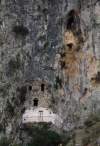 |  |  | ||||
 | ||||||
 |  |  | ||||

Founder
 The founder and first possessor of the Monastery was Saint Nilos Erihiotis (1228-1334), who came from Constantinople and was a descendant of the imperial generation of Laskaris. He became a monk at a very young age at the famous Monastery of Akimiton, where he changed his name from Nikolaos to Nilos. Many years later he was a pilgrim at Jerusalem.
The founder and first possessor of the Monastery was Saint Nilos Erihiotis (1228-1334), who came from Constantinople and was a descendant of the imperial generation of Laskaris. He became a monk at a very young age at the famous Monastery of Akimiton, where he changed his name from Nikolaos to Nilos. Many years later he was a pilgrim at Jerusalem.
 |  |  | ||||
 | ||||||
 |  |  | ||||
Coming back, he contradicted the Emperor Michael Paleologos 8th, over the disputable - at the time - issue of the union of the Eastern and Western Church. He was convicted for his convictions and was abandoned in a boat to be lost at sea. The Holy Providence led him to the coast of Mount Athos, to the Monastery Iviron, where he stayed for three years as a door - keeper.
Returning to Constantinople, he was honoured by the new Emperor, Andronikos Paleologos but he did not stay in the royal city for long. He started a new journey lasting for many years during which he visited many places in the Holy Land and then, passing through the Aegean islands, Peloponnesus and Corfu, he arrived at Avlona in Epirus (Vlore in Albania), where he stayed for some years.
 |  |  | ||||
 | ||||||
 |  |  | ||||
Some years later after an invitation from the residents of Thesprotia, he proceeded southwards to the area of Giromeri  and settled in an old hermitage in the cave of a steep rock.
and settled in an old hermitage in the cave of a steep rock.
Soon, a small fraternity of hermits were gathered near him. According to legend the hermits spotted a glittering light on the opposite mountain and upon investigation they discovered the icon of the Blessed Virgin Mary Odigitria (the Conductress). It was at this site where the foundations of today's Monastery were built.
 |  |  | ||||
 | ||||||
 |  |  | ||||
On the 2nd January 1334 at the age of 106 years old, Saint Nilos died, after drawing up his will and nominating his successor.  His body was interred a short distance from the Monastery and is still there today. Some years after his death, when its removal was attempted, a bulky rock fell and covered the grave, upon divine intervention. Nowadays, there is a small chapel on the grave of Saint Nilos.
His body was interred a short distance from the Monastery and is still there today. Some years after his death, when its removal was attempted, a bulky rock fell and covered the grave, upon divine intervention. Nowadays, there is a small chapel on the grave of Saint Nilos.




